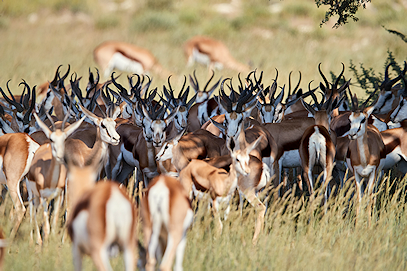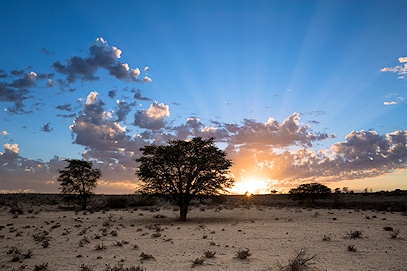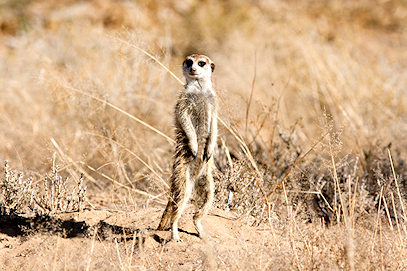South Africa and Botswana's Kgalagadi Transfrontier Park
Help Me Plan- Home
- >
- African Travel
- >
- South Africa
- >
- National Parks
- >
- Kgalagadi Transfrontier Park
Kgalagadi Transfrontier Park Destination Guide
The Kgalagadi Transfrontier Park spans the border of South Africa and Botswana and protects a vast sweep of the Kalahari. Covering about 38,000 km², it is an off-the-beaten-track destination famed for red dunes, dry riverbeds, black-maned lion, prolific raptor, and astonishing night skies, explored by scenic drives and remote 4x4 routes.
Getting There
By Air: Guests to the park will be met at OR Tambo International Airport and assisted in transferring to a domestic flight to Upington in the Northern Cape. The short flight will take you straight into the Kalahari region, so remember to pack something cool, especially if you are arriving in summer.
By Road: Kgalagadi is on the border of South Africa and Botswana, approximately 250 km from Upington, 960 km from Johannesburg, and 1,100 km from Cape Town. African Sky guests are driven by an experienced guide from Upington Airport in a private, air-conditioned vehicle through the panoramic Kalahari to the park.
Weather & Best Time To Visit
Although animals congregate around the riverbeds after the rains from March to May, wildlife viewing in Kgalagadi is exceptional all year round. The scorching rainy season from January to February brings terrific thunderstorms — a marvel to observe — if you don't mind temperatures exceeding 40 °C.
Similarly, winter nights can be freezing, and the temperatures can drop below 0 degrees at night. Birding is better in the winter than in the spring and summer seasons, but the cooler days make exploring on foot much more comfortable. The park does not get crowded, but it may be fuller during the school holidays.

The two major rivers of the Kgalagadi Transfrontier Park, the Nossob and the Auob, flow on rare occasions. Their beds meet near Twee Rivieren Camp, and the combined channel continues southward to enter the Molopo River outside the park. Kgalagadi does not support the diversity of antelope found in savanna parks, but an astonishing 19 species roam the area. Carnivores include the black-maned Kalahari lion, cheetah, brown hyena, African wild cat, and honey badger. Raptors such as martial, tawny, and bateleur eagle and the pale chanting goshawk are commonly sighted.
Reasons to visit Kgalagadi Transfrontier Park
Conservation
In the spirit of conservation, the former Kalahari Gemsbok National Park of South Africa and neighboring Gemsbok National Park in Botswana merged to protect the natural migratory patterns of wildlife. It is a cause for celebration, as the colossal park is home to never-ending splendor and awe-inspiring animal diversity.
Border Crossing
Traveling within Kgalagadi is a freeing experience as visitors can cross the border between South Africa and Botswana in search of various wildlife and environmental attractions. Visitors can even enter from Namibia at Mata-Mata. It makes the park an ideal destination to combine with parks in the three countries.
Black-maned Kalahari Lions
If you want to see the imposing black-maned Kalahari lion, a trip to Kgalagadi is a must. The dramatic contrast between their golden frame and the dark mane adds to their inherent intensity. However, it is essential to consider the park's size, and finding these black-maned cats can take time and effort.
Experiences to Savor at Kgalagadi Transfrontier Park
The contrast of their magnitude characterizes experiences to savor in the Kgalagadi Transfrontier Park — from encountering tiny meerkat to taking in the vast expanse of the desert and legion migratory herds.

Migrations
Once you have witnessed the seasonal migrations of the Kgalagadi's antelope, such as the wildebeest, you will understand why the two countries joined forces in conserving the natural routes of wildlife. Their trek along the dry lands in search of nourishment is simply inspiring.
Endless skies
The boundless heavens strikingly complement the unique landscape. The bright blue is often covered by clusters of snowy clouds that create great shapes as they navigate the sky. You will often find yourself staring unconsciously at the skies here.
Marvelous Meerkats
If you have never watched the series Meerkat Manor, you might start after visiting Kgalagadi. These little critters are quite comfortable around humans, and their active presence is not something you can easily forget.Useful Information
History
Kgalagadi Transfrontier Park is a product of South Africa and Botswana working together. It was founded on 12 May 2000 when presidents Thabo Mbeki and Festus Mogae formed Southern Africa's first peace park. The Kalahari Gemsbok National Park of South Africa and the Gemsbok National Park of Botswana formed this international reserve. The park's history dates back to 31 July 1931, when the Kalahari Gemsbok National Park was established on the South African side to protect migrating game. Eventually, in 1948, a verbal agreement was made with Botswana (then known as the Bechuanaland Protectorate) to conserve the whole area as one unit.
The park is named after the Kgalagadi people, whose language is related to Tswana. They were some of the first to move into this area and stayed peacefully with Khoe-speaking people. These people named the area “Kgalagadi,” which means “place of thirst.”
Wildlife
The Kgalagadi Transfrontier Park is an ideal place to view gemsbok (also known as oryx). The large size of the park allows the migration of wild ungulate and provides the predators that prey on them a large area to survive. The migratory ungulates include red hartebeest, blue wildebeest, springbok, and eland.
The park's most common predators are cheetah, hyena, and the famous black-maned Kalahari lion. leopard and wild dog are also spotted occasionally. More than 200 bird species have been documented, including vulture, eagle, buzzard, secretarybird, and ostrich.
Vegetation & Terrain
The terrain comprises red dunes, sparse grasslands, scrub bush vegetation, desert woodlands with occasional trees, the dry riverbeds of the Nossob and Auob Rivers, and salt pans. Locals believe that the rivers only flow once every hundred years. Underground water provides the necessary sustenance for the fauna, flora, and wildlife that call this desert home.
Activities
Game drives in the early mornings or late afternoons are available daily. Longer drives on various 4x4 trails, such as the Bitterpan and Mabuasehube, are available. A visit to the Predator Centre at Nossob is a great way to learn more about the habits of Kgalagadi's predator species.









